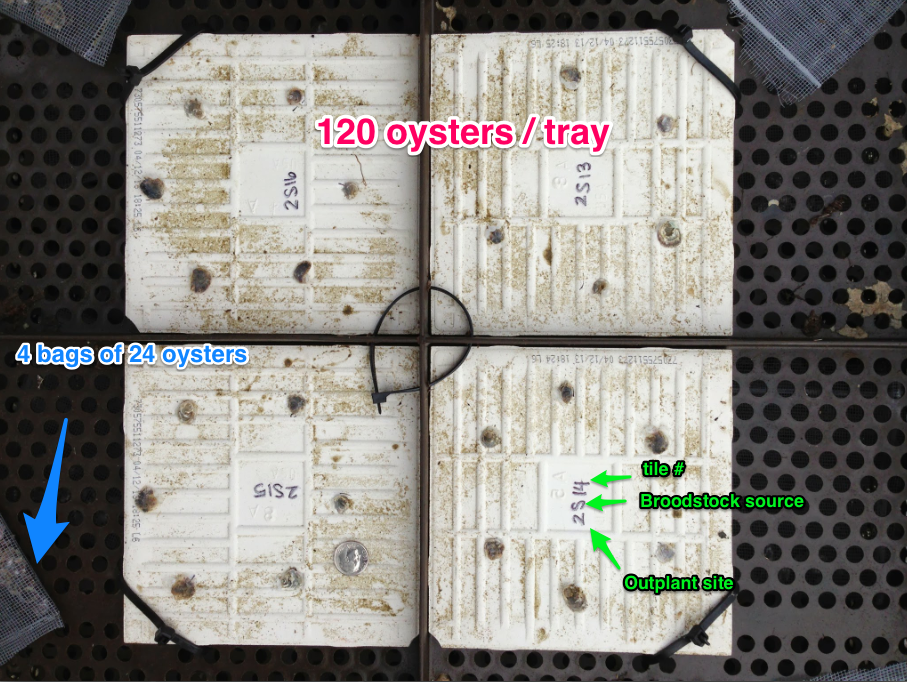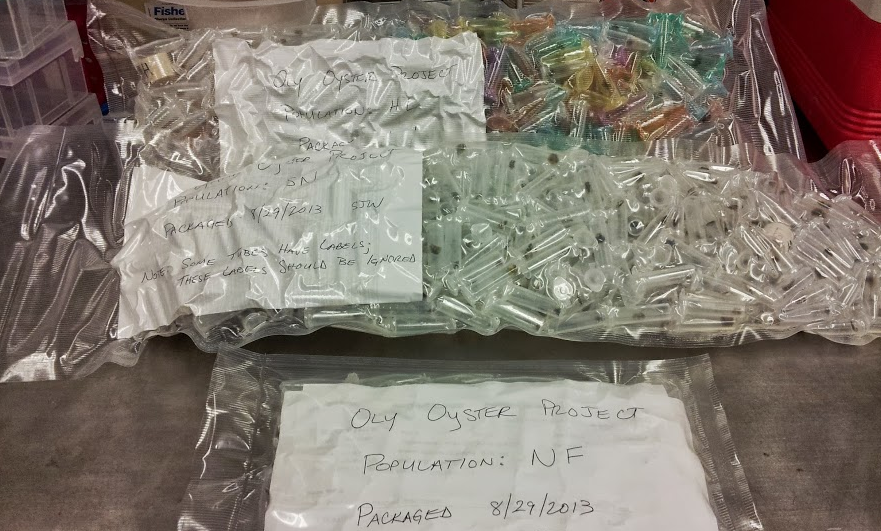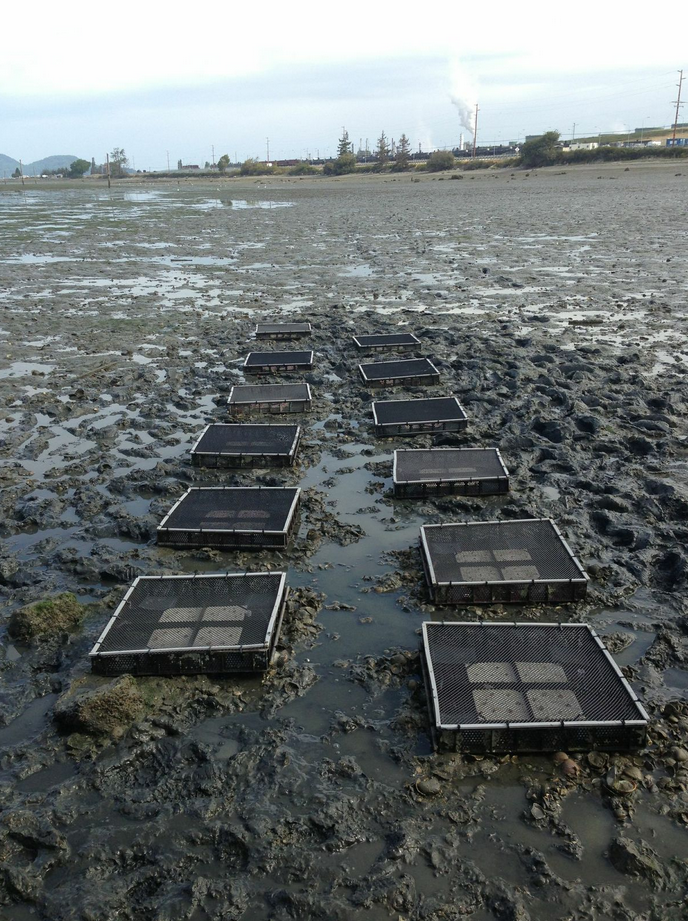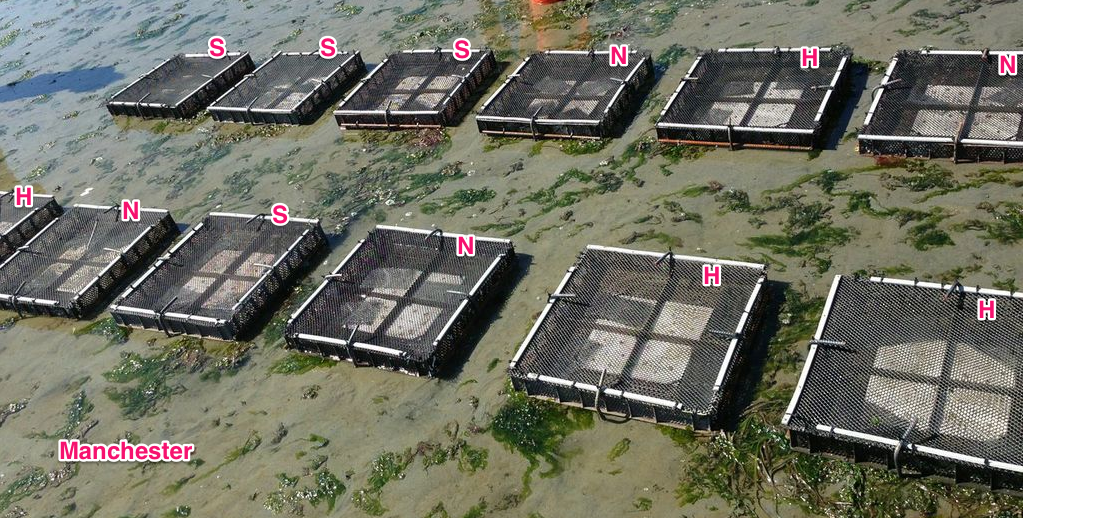General Aspects of August 2013 Outplanting
Table of Contents
- South: Oyster Reserve (North Bay--need to confirm with Brian Allen, PSRF)
- Hood Canal: Dabob Bay-Long Spit
- North: Fidalgo- Collected by PSRF
Deployment sites:
-South: Oyster Bay, Duane Fagergren's farm
-Hood Canal: Dabob Bay, Long Spit, Rocky Point Oyster Co.
-North: Fidalgo, just north of the trestle trail
-Central: Clam Bay, in front of NOAA Manchester Lab
Hobo temperature loggers were placed in two trays. In each tray there were small pieces of PVC pipe with broodstock designation. The three designations on the PVC pipe were as follows (designations were taken from PSRF):
HL = Hood Canal, Long Spit
SN = Oyster Bay, North Bay
NF = Fidalgo Bay, Fidalgo Bay
On each tile, a three point code was used in the following format [Plantout site, Broodstock Location, Tile Number (1-16)]. Each tray also contained 4 bags of 24 oysters, one for each quadrant of the trays. Oysters need to be removed from the bags at October low tide series.
Planting site codes
1 = Oyster Bay, South Sound
2 = Fidalgo Bay, North Sound
3 = Dabob Bay, Hood Canal
4 = Manchester Lab, Central Sound
Broodstock Location codes
H = Hood Canal
N = North Sound
S = South Sound

Samples from each population where taken for later genetic analysis. Whole seed were individually frozen at -80.

South Puget Sound
The first deployment was on Sunday August 18 in Oyster Bay at about a -1 MLLW tidal elevation. 12 trays were transported inside vehicle and about an hour of tray prep work took place on the side of the road. Trays were secured (tiewraps) to metal rack that projected ~ 3inches from substrate. Trays were secured in a single line in parallel to the shoreline.
Coordinates:
47 07' 59" N
123 01' 18" W
47.140496, -123.016523
All Photos
Present: Joth Davis, Steven Roberts, Brent Vadopalas, Katie Jackson, Hannah Wear
Closest Environmental Monitors:
Totten Inlet -- Windy Point
NOTE: Trays should be moved and staked down to firmer substrate at same tidal elevation at October low tide to prevent winter freeze mortality.
North Puget Sound
The second deployment was made in Fidalgo Bay, just north of the trestle trail at about -1 MLLW. Trays were transported from Port Gamble via Port Townsend and Whidbey Island. Tray prepwork was conducted at the March Point Park & Ride immediately prior to deployment. Trays were transported via handcart along the trestle and lowered to the tideflat by rope.
Trays were arranged in two rows parallel to the shoreline, staked directly into the mud. This seems to be the most muddy substrate of all sites.
Coordinates

All Photos
Present: Steven Roberts, Brent Vadopalas, Hannah Wear, Paul Dinnel
Closest Environmental Monitors:
Site check 8/21/13

Central Puget Sound
Trays were transported inside a SUV to the head of Dabob Bay at Rock Point Oyster Co. Trays were carried a long distance across the tide flats and staked at about a -1 MLLW elevation. There were some issues with this deployment and plans to relocate to Broad Spit in Dabob Bay because of proximity to stormwater runoff/scour. This relocation may occur in Sept.
Coordinates
47.573319, -122.544884
47°34'23.9"N 122°32'41.6"W

All Photos
Present: Brent Vadopalas, Sam White, Joth Davis, Earl Steele, Rock Point Oyster Co. farm manager (name??)
Closest Environmental Monitors:
Manchester
Oysters were deployed at the NOAA Research Station at Manchester at ~10:30 AM on Wednesday August 21, 2013. This site does not correspond to a broodstock population but rather serves as backup / additional site. Trays were carried across the tidal flat some distance and place in two rows. A substantial amount of macroalgae (primarily Ulva spp) was present. Substrate was quite soft with some concern about the stakes holding.
There was an adjacent experiment looking at the ecology of the location using manila clams as a bioindicator (growth, survival?). The clam project seemed to be based out of the NOAA Montlake Station. Researchers arrived via boat while we were deploying.
Coordinates:
47 34' 16" N
122 32' 50" W

All Photos
Present: Steven Roberts, Brent Vadopalas, Sam White, Frederick Goetz, Doug Immerman
Closest Environmental Monitors: